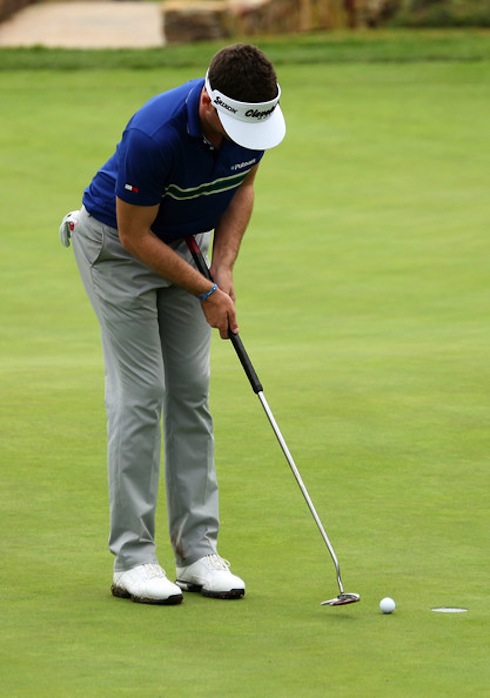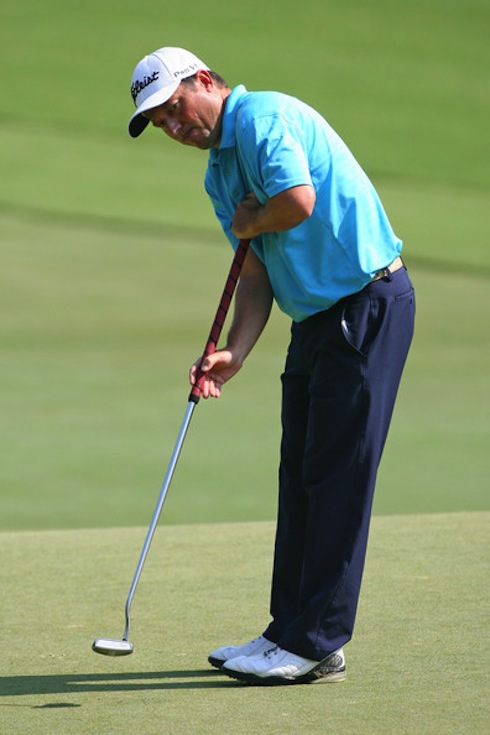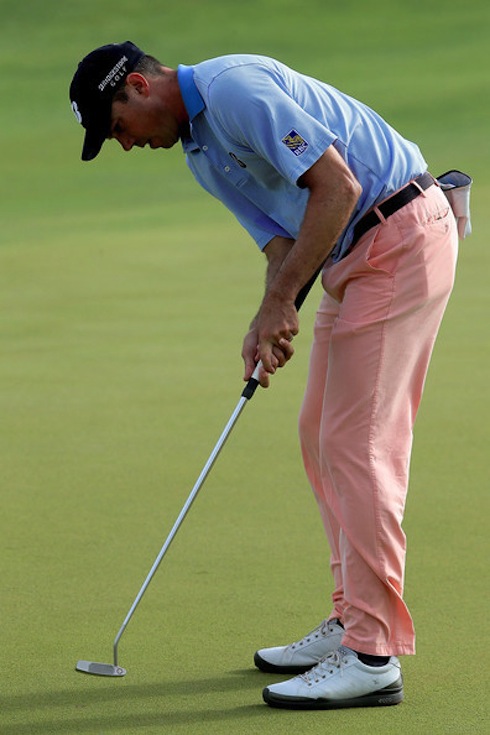 In 2016, anchoring putters will be outlawed, and the joint USGA/R&A ruling caused quite a stir when the proposed ban was announced. The ruling bodies contend that anchoring a golf club to the body is not a swinging motion, and thus not allowable under the Rules of Golf. Supporters of belly and long putters rely on arguments like “the game is evolving,” “long putters will grow the game,” and “they don’t provide an advantage.”
In 2016, anchoring putters will be outlawed, and the joint USGA/R&A ruling caused quite a stir when the proposed ban was announced. The ruling bodies contend that anchoring a golf club to the body is not a swinging motion, and thus not allowable under the Rules of Golf. Supporters of belly and long putters rely on arguments like “the game is evolving,” “long putters will grow the game,” and “they don’t provide an advantage.”
Because it’s a decision that involves $300 putters, three of the last five major winners, and putting guru Dave Pelz, it made noise in the sports world despite the basketball and football seasons being in full swing.
Reactions to the decision have been interesting, to say the least. Several forum threads (here and here) revealed that golfers were against a ban in 2007, but times have changed, and another poll has a majority of responders supporting the ban. Golf writers, on the other hand, seem staunchly against the ban, and many have been quick to criticize the ruling. Professional golfers seem similarly split, so let’s take a bit of time to respond to what people have had to say.
Number Five: The Timing
The first argument comes courtesy of GolfChannel.com writer Rex Hoggard, who, in a GolfChannel roundtable, insists that the ruling bodies should have instituted the rule more swiftly.
Yes.
…
The decision to ban anchoring is the right one, albeit a few decades late and with far too much of a pause between enactment and enforcement.
…
The USGA and R&A acted correctly just not quickly enough. If approved next spring, the ban on anchoring would begin in 2016, which means we will play three seasons and 12 major championships under the cloud of an impending ban.Rex Hoggard
This is the one point on which I disagree with Hoggard. First: the current issue of the Rules of Golf is marked “2012-2015.” 2016 is already the next time the Rules are set to be tweaked. If the Rules were to be changed now, the USGA and R&A would be essentially invalidating those books, which would only create more confusion. It’s certainly possible, but not ideal. Second: we don’t have a whole lot to go on with momentous rule changes in golf; it just doesn’t take very long to adjust to a limit on CoR or MOI. But we can look at the late-2000s move away from deeper grooves.
 We can argue until the greenskeepers pack it up and go home for the night about whether or not the groove rule was necessary, but one thing is apparent: they rolled it out right. Tour players were given a few years to adapt, and but ultimately told “This is the way it’s going to be, get used to it.” Amateurs were given more time to adapt (those who compete still have until 2014 to comply, those who don’t have until 2024 when it becomes an official rule) to ease the pain of letting go of brand-new but non-conforming wedges.
We can argue until the greenskeepers pack it up and go home for the night about whether or not the groove rule was necessary, but one thing is apparent: they rolled it out right. Tour players were given a few years to adapt, and but ultimately told “This is the way it’s going to be, get used to it.” Amateurs were given more time to adapt (those who compete still have until 2014 to comply, those who don’t have until 2024 when it becomes an official rule) to ease the pain of letting go of brand-new but non-conforming wedges.
The anchoring rule is similar, but the differences are large enough that the same rollout could not have been employed. First of all, it’s a technique rule, not an equipment rule (since longer-than-normal putters are still legal), so the ruling bodies couldn’t just wait for OEMs to stop making long putters. Second, the groove rule is inconsequential enough for the recreational golfing population that the small bit of bifurcation it introduced simply didn’t matter, but the type of fragmentation that would be caused by a partial belly putter ban would have been illogical, as Mike Davis has said. And third, the magnitude of the decision was, frankly, different. The groove rollback affected everyone, while the anchoring rule only affects a small percentage of golfers.
Maybe saying “it’s only fair” is going to far, but golf is a more interesting game to watch when Ernie Els, Webb Simpson, Keegan Bradley, and Tim Clark are playing well, and it would be nice if they found the path to good putting even with a normal-length model (and if they could then share that path with me, that would be nice).
Number Four: Putting Evolution
The next point is from that same roundtable, courtesy of Jason Sobel, who decided that non-golfers would be best-equipped to make the decision:
No.
…
Call me anchored to the fence, but I couldn’t make up my mind. I could see everyone’s point; nobody didn’t make sense. I was my own personal hung jury.And then I changed my strategy. Instead of speaking about it with golfers, I spoke with those who don’t play it at all.
In a series of conversations with friends who understand the game but don’t play, I often had the following exchange:
“They’re probably going to ban anchoring the putter soon.”
“Why?”
“Well, it’s against the traditional stroke that’s been used for hundreds of years.”
“So what? It’s called progress. Evolution. Times change. We should change, too”
…
Everything else in the game – from courses to equipment – has evolved over time.Jason Sobel
Let’s start off by addressing the assertion that long putters are some new sort of innovation.
High-strength alloys and composites that are also unthinkably light is innovation. Carbon fiber shafts that damp vibration better than steel while also aiding in distance is an innovation. Adams’ aerodynamic inroads and the crazy dedication to lightness shown by several OEMs are innovations. Epoxying an extra-long shaft to an oversized putter head and sticking the butt end of the grip in your gut is not.
 Furthermore, saying that it’s just the natural progression of putting is just plain wrong. Sports have developed norms. Basketball players (save very few) shoot overhand. Hockey players shoot with one hand at the butt of the grip, and one extended farther down. Baseball players hold a bat at their ears and then move their hands and wrists in an elliptical path to hit the ball. And golfers, by and large, have swung the club with their hands. It’s not being stubborn to want the game of golf to be played similarly to the way it used to be. It lets us compare Tiger to Hogan and Nicklaus with at least a modicum of accuracy. Progress and evolution are noble, sure, when they just making clubheads lighter or the traditional golf swing more efficient. But anchoring putters is much closer to throwing a spitball or stickum on football gloves than it is to forged composite.
Furthermore, saying that it’s just the natural progression of putting is just plain wrong. Sports have developed norms. Basketball players (save very few) shoot overhand. Hockey players shoot with one hand at the butt of the grip, and one extended farther down. Baseball players hold a bat at their ears and then move their hands and wrists in an elliptical path to hit the ball. And golfers, by and large, have swung the club with their hands. It’s not being stubborn to want the game of golf to be played similarly to the way it used to be. It lets us compare Tiger to Hogan and Nicklaus with at least a modicum of accuracy. Progress and evolution are noble, sure, when they just making clubheads lighter or the traditional golf swing more efficient. But anchoring putters is much closer to throwing a spitball or stickum on football gloves than it is to forged composite.
Number Three: For the Good of the Game
Again from that roundtable, Ryan Lavner:
No.
…
I understand that the governing bodies’ proposed rule to ban the anchored stroke is intended to give structure to the game. But this ruling hurts those at the recreational level. My level. Your level.Most of us don’t play so that we can someday compete in the U.S. Amateur. We play because of the camaraderie, and the thrill of a crisp shot, and the possibility that, just maybe, today we will break 100, or 90, or 80.
Ryan Lavner
Let’s break this one down into two categories: people who keep a handicap and/or pay competitively, and people who don’t. It has been argued that this ruling will discourage recreational golfers from playing, but here’s why that makes no sense:
If you’re the first type of golfer I described (plays amateur events and/or keeps a handicap), it’s doubtful that any rule change will affect the enjoyment you get from the game enough to quit. Did every owner of the banned Callaway ERC II quit golf when they were banned? No, of course not. They bought an ERC III and learned to live with five fewer yards off the tee.
And if you just play to get exercise, don’t play for money, don’t keep an official handicap, already take gimmies, roll the ball out of crappy lies, and don’t take stroke and distance when you slice one out of bounds, then keep anchoring. No one cares. The USGA Police aren’t going to fine you or anything, and you’ll still be able to buy a belly putter if you want to. Go for it.
 This is tangential to one of the biggest points brought up by those against the proposed rule, that golfers with balky backs will struggle without anchoring. I call BS.
This is tangential to one of the biggest points brought up by those against the proposed rule, that golfers with balky backs will struggle without anchoring. I call BS.
Anchoring a putter to your body does absolutely nothing for your back. Adam Scott (long putter) and Keegan Bradley (belly putter) have the same spine angle as someone using a regular-length putter. In fact, if you really want to see someone who needed a longer putter to save their back, look at the 39-inch Ping Angel Cabrera used to win the 2009 Masters. 39 inches is right between regular putter and belly putter, and despite Angel’s sizable gut he didn’t anchor. Rather, he stood up a bit straighter and gripped the putter like it was normal-size, and that that’s what saved his back. If you want to save your back, do it by actually standing up straighter, not sticking the butt end of the grip in your navel.
Number Two: A One-Sided Chat with Dave Pelz
We turn now to Dave Pelz, former scientist, current proponent of the straight-back-straight-through putting stroke, who wrote a column on Golf.com shortly before the proposed rule was announced pleading with the ruling bodies to keep anchoring legal.
To the USGA: Golf is losing players. We need to grow the game, not shrink it. I’ve talked to you personally and sent e-mails full of data, trying to convince you to reconsider your stance on belly putting. I think you are not listening or looking at the way the game is played by the masses, but instead are reacting to a few PGA Tour pros on TV who have offended your egos!
Dave Pelz
Yes, proponents of the rule believe that anchoring a putter isn’t a stroke. They must not be capable of rational thought!
Are you planning to ban the long and belly putters because you don’t like the looks of them?
Dave Pelz
Let me stop you right there, Dave.
The way the belly putter looks has nothing – NOTHING – to do with the decision. Okay?
Otherwise we would have to ban painter’s hats, buttoning the top button of a polo shirt, Ryan Moore’s entire wardrobe, Jim Furyk’s swing, and the old Scotty Cameron Futura putter. In that case the people who have been crying “the USGA has more pressing issues at hand!” might have had a case.
You probably think they provide an unfair advantage, or you want them gone because Ernie Els, Webb Simpson and Keegan Bradley won major championships with them.
Dave Pelz
But you can’t prove an unfair advantage (none of the top 20 putters in 2012 used them), so you say you don’t like the way they look.
Dave Pelz
Looks like Dave figured that one out on his own!
(For the record, that stat is somewhat flawed. Of course the top 20 putters wouldn’t use belly putters; good putters don’t turn to belly putters. Poor putters do, and if they become average putters, that may be enough to remain on the PGA Tour while hiding safely among the middle of the putting stats.)
We should forget this “look bad” excuse and talk reality.
Dave Pelz
I agree. Let’s continue.
Long/belly putters really do provide an advantage for some golfers when they minimize the wrist break and forearm rotation of some players. But not all golfers (and very few pros) have this problem, so these putters don’t help everybody.
Dave Pelz
I just jumped up from my seat and am now waving my arms around in astonishment. An unfair advantage can’t be proved, but they do offer an advantage, but only to some golfers … so let’s keep them legal! Iron-clad logic right there.

You didn’t mind the long/belly look when Orville Moody won the U.S. Senior Open in 1988, or when millions of golfers adopted them over the last 20 years. But this year they’ve all of the sudden started to look so bad that you can’t take it anymore?
Dave Pelz
Correction: the USGA didn’t care, at least enough to act. Some golfers have been crying out for a ban for a long time. If anything, this should have happened long ago. The fact that the decision looks reactionary is unfortunate.
Banning this method of putting will drive people from the game and make it less enjoyable for those who have to change the way they putt.
Dave Pelz
Addressed above.
Number One: Tour Players on Twitter
A collection of some PGA Tour players’ rections, thanks to ESPN.com.
Gary Player
It’s time for bifurcation like most other sports. If you think the game is the same for all, just watch Tiger or Rory vrs your club champ.@garyplayer
Paul Azinger
What’s so bad about Langer, Els & Couples finding a way to lengthen their careers with anchored putters? 5 more yrs of Hogan wlda been cool@paulazinger
Colt Knost
This years player meeting at San Diego could be interesting! #tension@ColtKnost
Rory Mcilroy
Fully agree with the anchoring ban. Better image for the game of golf, skill and nerves are all part of the game. Level playing field in ’16@McIlroyRory
Dustin Johnson
Anchored putter ban makes no difference to me. Didn’t care for ’em in the first place!!!@DJohnsonPGA
Graeme McDowell
Careful and considered from the USGA/R&A on rule change banning anchoring of a golf club to the body. Only decision that could be made #2016@Graeme_McDowell
Ian Poulter
The long putter rule change will cause some unsettle I’m sure. I’ve always putted with a short putter so I’m not affected by the change.@IanJamesPoulter
Closing and Your Thoughts?
I’d like to close out this article with my favorite stat to come out of this whole episode. In 2004, when he was still using a normal-sized putter, Adam Scott, the current posterchild for brooksticks, lead the PGA Tour in strokes gained – putting, possibly the best metric we currently have for measuring the game on the greens.
Photo Credits: © Stuart Franklin, © Hunter Martin, © Stephen Dunn, © David Cannon.

Not you too, Jamo! I liked you. 🙁
Nice article Jamo.
Anchor putters were a fraud to the game. If you can’t putt you can’t play.
very nice article
I’m against anchoring, but at this point it’s almost too big to fix. The PGA Tour should’ve been all over this years ago (before it became a big deal). If I were any player that has won on tour with an anchored putter, I would feel my win has been cheapened by the implementation of this rule.
Its absurd that now we have a changing of the rules after all the success of players using them. Would it have been changed if no one had success with it? A rule should NOT be implemented as an afterthought. I understand though, at this point, it’s the only option.
Probably the best article I have read on this subject.
Also thank you for pointing out in a very logical manner that Pelz is a moron.
I agree completely.. Pelz IS a moron.
Well written Jamo. I’m sure there will be a lot of griping, as there was for the groove rule change. No one talks about that now. But in the end, guys like Keegan are way too talented to be held back. He will be fine without it.
dave pelz is a moron. anchored putters have nothing to do with who plays this game, who continues to play and who quits. i’ve been a poor putter my entire life and keep playing. i keep hoping one day i’ll find the right stroke while still keeping my integrity. long putters also have nothing to with helping a bad back. if anything, i think belly putters hurt your back even more. i think the USGA took notice when a 14 year old qualified for the masters using a belly putter. what was once looked at as a last resort has now become the first choice. this is one thing the USGA got right. now let’s eliminate light weight driver heads and shafts and bring back metal spikes.
I just recently went to a belly style putter and it does help me with putting. I don’t mind the ruling BUT you can’t tell me that a belly or long putter is that much of an advantage to a player. The hybrid, in my opinion was the single biggest advancement to the game. Yet it’s okay for people to use them?
I do think that bifurication is in order in golf. Like the hybrid, the long/belly putters help the common golfer. All PGA professionals should be able to play with any putter. I also think that PGA players should be able to hit a 2 iron and not a 2 hybrid.
——————————————————-
COMMENT FROM JAMO…
We turn now to Dave Pelz, former scientist, current proponent of the straight-back-straight-through putting stroke…
——————————————————-
Pelz is not a “former” scientist. His whole short-game and putting technique regimen was developed from systematic analysis and observation of short-game behaviors, and ways to improve consistency.
Pelz’ full method is a bit much for me, but he is still a very active scientist of the technique of putting.
———————-
MORE JAMO COMMENTS…
Yes, proponents of the rule believe that anchoring a putter isn’t a stroke. They must not be capable of rational thought!
———————-
Lame comment, Jamo. It tarnished your otherwise interesting piece. Pelz never said they weren’t capable of “rational thought.” You implied his statement meant that, but it didn’t.
Anyway, being 62 years old, I support the anchored putting because it will extend the game for older players, including those who have a slight hand tremor, the physical component of the “yips.” Note that I use a 33″ putter which I stroke with the lead hand low – I tried longer putters and didn’t get much from them. But, I know several senior golfers who like the longer anchored strokes – both for relief from the yips and back pain.
If need be, I go with Gary Player and would accept some “bifurcation” in the rules of golf. The anchoring issue could better be handled as a “Conditions of Competition” issue rather than making it golf dogma.
John, I disagree. Pelz is a former scientist. He might apply the scientific method to a few things here and there, but he’s more of an accountant or a statistician or a consultant than a scientist (and it’s not even close) in my opinion.
Also, I thought Jamieson’s comment – a reaction to a quote by Pelz – was spot on and amusing. Pelz is the one who was making little sense, and Jamieson called him on it. Again, my opinion, nothing more.
Erik,
Maybe I was a little hard on Jamo. I guess I haven’t fully snapped out of election-year combativeness.
I use a broomstick putter. It has taken nervous hands out of play and made putting more fun. I don’t think my putting stats have improved one bit but I am more comfortable and confident over the ball. It also allows me to stand more erect and takes stress off my sports injured lower back which means I can practice for longer periods of time. If asked, I would vote to keep the anchored putter stroke. It has been in play for too many years and won too many PGA tourneys to change it now. However, I do not believe in two sets of rules for the game of golf. For that reason I will make the switch back to a short putter and make it work.
John, just as you said: stand taller with a putter you don’t anchor. Ray Floyd did it. Your back will be fine (or, I should say, as fine as it is with an anchored putter standing more upright).
The argument is not about whether there’s an “advantage.”
How many golfers would play golf if there was no handicap system. Amateur golf is not an even playing field. The primary objective of golf is self improvement and enjoyment. Anything that increases the enjoyment of golf is good for the game. As far as professional golf goes, I would rather see caddies , than long putters banned. Golf is about an individual competing against a course and being able to match your wits and skill against it. Having someone calm you down when the course is winning, tell you what club to hit and even line you up is more of a blight on competitive golf than the broomstick.
I would rather they control the length the ball flies and remove or limit caddies involvement than outlaw the broomstick.